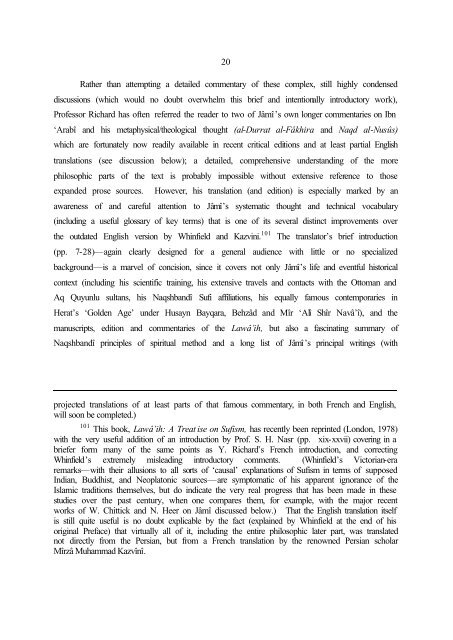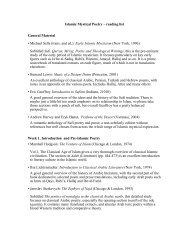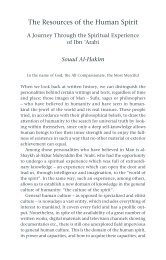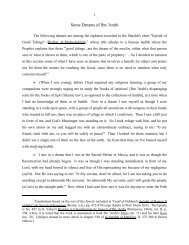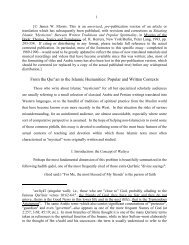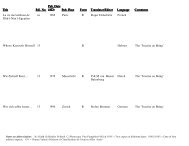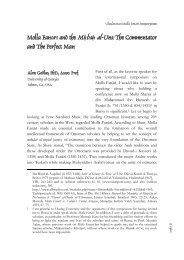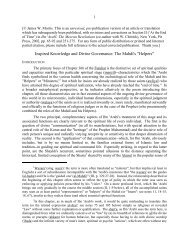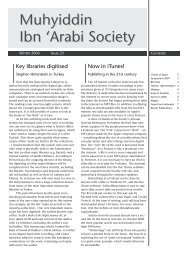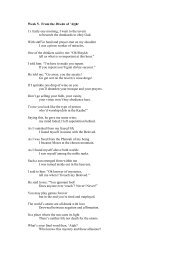Part III (pdf) - Muhyiddin Ibn Arabi Society
Part III (pdf) - Muhyiddin Ibn Arabi Society
Part III (pdf) - Muhyiddin Ibn Arabi Society
Create successful ePaper yourself
Turn your PDF publications into a flip-book with our unique Google optimized e-Paper software.
20Rather than attempting a detailed commentary of these complex, still highly condenseddiscussions (which would no doubt overwhelm this brief and intentionally introductory work),Professor Richard has often referred the reader to two of Jâmî’s own longer commentaries on <strong>Ibn</strong>‘Arabî and his metaphysical/theological thought (al-Durrat al-Fâkhira and Naqd al-Nusûs)which are fortunately now readily available in recent critical editions and at least partial Englishtranslations (see discussion below); a detailed, comprehensive understanding of the morephilosophic parts of the text is probably impossible without extensive reference to thoseexpanded prose sources. However, his translation (and edition) is especially marked by anawareness of and careful attention to Jâmî’s systematic thought and technical vocabulary(including a useful glossary of key terms) that is one of its several distinct improvements overthe outdated English version by Whinfield and Kazvini. 101 The translator’s brief introduction(pp. 7-28)—again clearly designed for a general audience with little or no specializedbackground—is a marvel of concision, since it covers not only Jâmî’s life and eventful historicalcontext (including his scientific training, his extensive travels and contacts with the Ottoman andAq Quyunlu sultans, his Naqshbandî Sufi affiliations, his equally famous contemporaries inHerat’s ‘Golden Age’ under Husayn Bayqara, Behzâd and Mîr ‘Alî Shîr Navâ’î), and themanuscripts, edition and commentaries of the Lawâ’ih, but also a fascinating summary ofNaqshbandî principles of spiritual method and a long list of Jâmî ’s principal writings (withprojected translations of at least parts of that famous commentary, in both French and English,will soon be completed.)101 This book, Lawâ’ih: A Treat ise on Sufism, has recently been reprinted (London, 1978)with the very useful addition of an introduction by Prof. S. H. Nasr (pp. xix-xxvii) covering in abriefer form many of the same points as Y. Richard’s French introduction, and correctingWhinfield’s extremely misleading introductory comments. (Whinfield’s Victorian-eraremarks—with their allusions to all sorts of ‘causal’ explanations of Sufism in terms of supposedIndian, Buddhist, and Neoplatonic sources—are symptomatic of his apparent ignorance of theIslamic traditions themselves, but do indicate the very real progress that has been made in thesestudies over the past century, when one compares them, for example, with the major recentworks of W. Chittick and N. Heer on Jâmî discussed below.) That the English translation itselfis still quite useful is no doubt explicable by the fact (explained by Whinfield at the end of hisoriginal Preface) that virtually all of it, including the entire philosophic later part, was translatednot directly from the Persian, but from a French translation by the renowned Persian scholarMîrzâ Muhammad Kazvînî.


